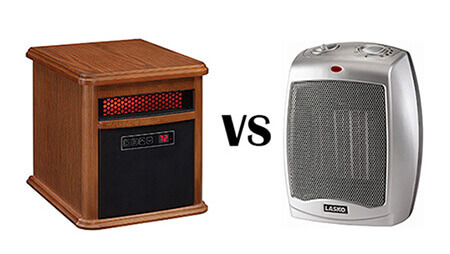
Are you looking for a space heater this winter season? There are a variety of heaters available in the market, including ceramic and infrared heaters. Both heaters work on the principle of transforming electrical energy into heat.
However, the significant difference between infrared and ceramic heaters hides in their functionality. If you want to reduce your heating costs, understand the difference between them. It will help you get the right one for your home.
How Does Infrared Heater Work Compare to Ceramic Heater?
One of the differences between the infrared and ceramic heaters is the way they work. Infrared heaters produce thermal energy and warm the person or object directly. On the other hand, a ceramic heater allows the heat to circulate and makes the air warm.
Infrared space heaters work on the theory of infrared radiation, while a ceramic heater works on convection heating. The infrared rays discharged by the heater can warm up anything in front of it. These rays affect our skin in a similar way the sun rays do. Our skin absorbs the light coming from the sun and helps us warm up in cold weather.
Just like the sun, the infrared space heater creates a beam of light through a particular wavelength. That, when absorbed, warms up our body.
The heating method in ceramic heaters has been used for a long time. This ceramic space heater provides continuous heat. However, to your satisfaction, there’s no fire risk involved, no matter how long they run.
The infrared heater provides warmth to a particular person or object while a ceramic heater can quickly warm a room or surrounding area.
READ NEXT: The Best Pelonis Electric Space Heater Reviews
Ceramic vs Infrared Heater Energy Efficiency
Although both ceramic and infrared space heaters are considered energy-efficient, the former is more efficient. Why?
That’s due to the presence of ceramic plates, making the heater cool down faster. Eventually, these heaters waste less heat as compared to other types of space heaters.
The ceramic space heaters can be 85 to 90% efficient. Follow these tips in order to get the most out of this heater:
- Make sure to shut all the doors so that heat doesn’t go out of the room.
- You can avoid heat loss with the use of thick curtains.
If you want an energy-efficient space heater but can’t get ceramic heaters due to some reasons, infrared space heaters are the next best alternative. They convert 100 percent of the utilized energy into heat.
An infrared heater needs only 40% of the energy to create a warm environment. The reason why infrared heaters are energy efficient is they are used to warm a particular individual. Hence, no extra heat energy is required.
Other Differences Between Ceramic and Infrared Heaters
The ceramic and infrared heaters are almost similar, but their features differ from each other. Here are a few differences between ceramic and infrared heaters.
Heating Area
The heating area of a ceramic space heater is larger compared to the infrared. Also, ceramic heaters come with fans, which are helpful in increasing the heat spread.
An infrared heater, also known as a radiant heater, has a slim structure, which is suitable to heat up a small room. A small heating area doesn’t mean it can’t provide much warmth as it can warm up a given in a short time.
Portability
Ceramic heaters are extremely portable. So, shifting them from one room to another won’t be a problem, which is a huge advantage.
While a ceramic heater’s compact design makes it a must-have for any house, infrared heaters don’t give that luxury. They can only function when you mount them on walls or ceilings. That, precisely, serves the purpose of target heating rather than heating the entire space.
READ ALSO: Best Portable Bathroom Heaters
Safety
Infrared heaters are not recommended for those having kids and pets in their house. The reason is the heat coming from the infrared heater is unbearably hot. But infrared heaters are good for your health compared to ceramic ones.
Ceramic space heaters are a better option when it comes to safety as they consist of a handy device that prevents it from overheating, thus avoiding fire and other dangerous circumstances.
RELATED POST: Pet Friendly Space Heaters
Noise Pollution
No one enjoys unnecessary sounds around them, and the noise coming from a heater is a big no. Infrared heaters are exceptionally noiseless while functioning. In contrast, the ceramic heaters create noise due to the in-built fan that’s there to make the air warm.
Cost
When it comes to heating a small space, quartz infrared heaters are efficient as compared to ceramic heaters. However, though both heaters cost the same, infrared heaters consume larger amounts of electrical energy to convert it into heat.
It will not have a major effect on your electricity bills, but you might want to consider it if you want to cut down on your energy expenses.
Infrared vs. Ceramic Heater: Which One is Better?
In the end, we will say both the heater types have their own unique features. The decision depends on your personal choice based on:
- Your budget (buying cost and monthly expenses)
- Heating requirements
- Room dimensions
If you want to warm your entire house on a chilly night, using an infrared heater would be a waste of money and resources. But you won’t regret it with ceramic heaters as they’re more efficient in making your home cozier.
Conclusion
Infrared and ceramic space heaters have unique elements and structures. Their features and advantages distinguish them from each other.
Ceramic heaters can be expensive but they’re smart enough to reduce your energy bills gradually. They can heat up large spaces and are portable builds, so you can shift them to other rooms if needed.
Infrared heaters, on the other hand, are cheaper but don’t expect them to cut down your energy bills. As they’re mounted on walls or ceilings, they cover limited space and are best for smaller rooms. However, if you have pets or kids, we won’t recommend these.
In the end, it’s your decision to choose the right build. Consider your requirements and choose wisely.





